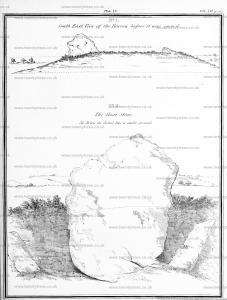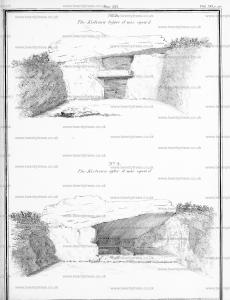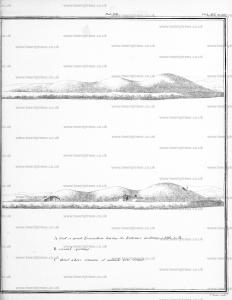Archaeologia Volume 16 Appendix
Archaeologia Volume 16 Appendix is in Archaeologia Volume 16.
November 20, 1806. An account of a Tumulus [Hoar Stone Long Barrow [Map]], opened on an estate of Matthew Baillie, M. D. in the parish of Duntesbourne Abbots, in Gloucestershire, communicated to Samuel Lysons, Esq. Director, by the Rev. Anthony Freston, Rector of Edgeworth, in the same county.
The length of the Barrow was about forty yards, and the width thirty; it contained about eight or nine bodies of different ages; it was composed of loose quarry stones; the largest stone, at the east end, has been long known, in that County, by the name of the Hoar Stone. It is of the calcareous kind, twelve feet high, fifteen in circumference, and weighs probably about five or six tons. All that part under the dotted line was below the surface of the ground.
See Plate LV.
N° 1. South east view before it was opened. 2. The Hoar Stone.
Plate LVI. 3. The Kistvaen before it was opened. 4. The same, after it was opened.


November 20, 1806. The Rev. W. H. Thornbury, in two letters addressed to the Rev. John Brand, M. A. Secretary, and William Bray, Esq. Treasurer of the Society, sent an account of a Barrow [Norn's Tump aka Avening Long Barrow [Map]], opened in the parish of Avening, in Gloucestershire, whose length, from east to west, was fifty-five yards, the greatest breadth nineteen two-thirds, and the smallest twelve yards and one-third; having within it two small chambers, in one of which were found eight, and in the other three skeletons, but no celts or other remains, except some bones of animals, which were buried in the Tumulus at C. Pl. LVII.
Mr. Fosbrook, F. A. S. in a letter addressed to the Society, observes, that as none of the characteristic marks of its being Danish, Saxon, or Roman exist, it may possibly be British, and have been formed before the Roman invasion.
